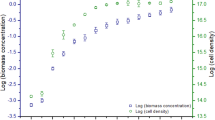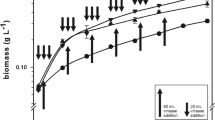Abstract
In order to maximize microalgae biomass production and reduce its overall costs, it is important to optimize inoculum conditions based on its physical and physiological characteristics. Chlorella sorokiniana cultures inoculated with inoculum at three different physiological stages (lag, exponential, and stationary) diluted to the same optical density were cultivated for 12 days under three different CO2 concentrations (0.038, 5, or 10 % CO2 v/v) and growth pattern and biomass production was observed. Samples inoculated with lag phase inoculum supplied with 5 % CO2 achieved the maximum biomass production, whereas samples supplied with 0.038 % CO2 never reached exponential growth. The better growth of samples inoculated with lag phase inoculum was attributed to its increased number of cells compared to the other two inocula.







Similar content being viewed by others
References
EPA (2011) Inventory of U.S. Greenhouse Gas Emissions and Sinks: 1990–2009. Washington: DC, USA.
Brune, D. E., Lundquist, T. J., & Benemann, J. R. (2009). Journal of Environmental Engineering, 135(11), 1136–1144.
Chinnasamy, S., Bhatnagar, A., Hunt, R. W., & Das, K. C. (2010). Bioresource Technology, 101(9), 3097–3105.
U.S. DOE (2010) National Algal Biofuels Technology Roadmap. U.S. Department of Energy, Office of Energy Efficiency and Renewable Energy, Biomass Program. College Park, Maryland, USA.
Schenk, P. M., et al. (2008). Bioenergy Research, 1(1), 20–43.
Kunjapur, A. M., & Eldridge, R. B. (2010). Industrial and Engineering Chemistry Research, 49(8), 3516–3526.
Yewalkar, S., Li, B., Posarac, D., & Duff, S. (2011). Energy & Fuels, 25(4), 1900–1905.
Keffer, J. E., & Kleinheinz, G. T. (2002). Journal of Industrial Microbiology and Biotechnology, 29(5), 275–280.
Li, Y. C., et al. (2011). Bioresource Technology, 102(8), 5138–5144.
de Morais, M. G., & Costa, J. A. V. (2007). Energy Conversion and Management, 48(7), 2169–2173.
de Morais, M. G., & Costa, J. A. V. (2007). Biotechnology Letters, 29(9), 1349–1352.
Sung, K. D., Lee, J. S., Shin, C. S., Park, S. C., & Choi, M. J. (1999). Bioresource Technology, 68(3), 269–273.
Porra, R. J., Thompson, W. A., & Kriedemann, P. E. (1989). Biochimica et Biophysica Acta, 975(3), 384–394.
Becker, E. W. (1994). Microalgae: biotechnology and microbiology. New York: Cambridge Studies in Biotechnology.
Stumm, W. (1996). Aquatic chemistry chemical equilibria and rates in natural waters. New York: Wiley.
Khalil, Z. I., Asker, M. M. S., El-Sayed, S., & Kobbia, I. A. (2010). World Journal of Microbiology and Biotechnology, 26(7), 1225–1231.
Hirata, S., Hayashitani, M., Taya, M., & Tone, S. (1996). Journal of Fermentation and Bioengineering, 81(5), 470–472.
Putt, R., Singh, M., Chinnasamy, S., & Das, K. C. (2011). Bioresource Technology, 102(3), 3240–3245.
Ketchum, B. H., Lillick, L., & Redfield, A. C. (1949). Journal of Cellular and Comparative Physiology, 33(3), 267–279.
Ketchum, B. H., & Redfield, A. C. (1949). Journal of Cellular and Comparative Physiology, 33(3), 281–299.
Benamotz, A., & Gilboa, A. (1980). Marine Ecology Progress Series, 2(2), 157–161.
Agrawal, S. C. M. (2007). Folia Microbiologica, 52(4), 399–406.
Cerveny, J., Setlik, I., Trtilek, M., & Nedbal, L. (2009). Engineering in Life Science, 9(3), 247–253.
Carbon Dioxide-Carbonic Acid Equilibrium 2004. Available from: http://ion.chem.usu.edu/~sbialkow/Classes/3600/Overheads/Carbonate/CO2.html. Accessed 14 Nov 2011.
Acknowledgments
This work was partially funded by grants and subcontracts from the US DOE and the State of Georgia. The authors acknowledge the assistance of other members of the Biorefining and Carbon Cycling Program's Algae-Biofuels Lab in analytical analysis.
Author information
Authors and Affiliations
Consortia
Corresponding author
Rights and permissions
About this article
Cite this article
Mattos, E.R., Singh, M., Cabrera, M.L. et al. Effects of Inoculum Physiological Stage on the Growth Characteristics of Chlorella sorokiniana Cultivated Under Different CO2 Concentrations. Appl Biochem Biotechnol 168, 519–530 (2012). https://doi.org/10.1007/s12010-012-9793-6
Received:
Accepted:
Published:
Issue Date:
DOI: https://doi.org/10.1007/s12010-012-9793-6




